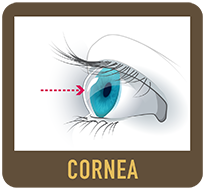Germs & Infections
Being able to see well is a vital aspect of performing daily activities for most people. Worldwide, many people rely on contact lenses (as well as glasses and eye surgery) to improve their sight. Contact lenses can provide many benefits, but they are not risk-free—especially if contact lens wearers don’t practice healthy habits and take care of their contact lenses and supplies 1. If patients seek care quickly, most complications can be easily treated by an eye doctor. However, more serious infections can cause pain and even permanent vision loss, depending on the cause and how long the patient waits to seek treatment 2, 3.
Keratitis
Contact lens wear is linked to higher risk of keratitis 2, or inflammation of the cornea (the clear dome that covers the colored part of the eye). Many contact lens wearers do not care for their contact lenses and supplies as instructed, which increases their risk of eye problems like keratitis 4-6.
 Keratitis in contact lens wearers can be caused by many factors 7. One type of keratitis, called microbial keratitis, can occur when germs invade the cornea. These germs—such as viruses, bacteria, fungi, or parasites (amebae)—are more likely to invade the eyes when contact lenses are worn for too long or are not cared for correctly 7, 8. Microbial keratitis is a serious type of eye infection in contact lens wearers, which can lead to blindness or the need for corneal transplant in the most severe cases 7.
Keratitis in contact lens wearers can be caused by many factors 7. One type of keratitis, called microbial keratitis, can occur when germs invade the cornea. These germs—such as viruses, bacteria, fungi, or parasites (amebae)—are more likely to invade the eyes when contact lenses are worn for too long or are not cared for correctly 7, 8. Microbial keratitis is a serious type of eye infection in contact lens wearers, which can lead to blindness or the need for corneal transplant in the most severe cases 7.
Types of Microbial Keratitis
Symptoms of Eye Infection
- Irritated, red eyes
- Worsening pain in or around the eyes—even after contact lens removal
- Light sensitivity
- Sudden blurry vision
- Unusually watery eyes or discharge
Prevention
Microbial keratitis can usually be prevented through healthy habits and proper care of contact lenses and supplies 9. Keep your eyes healthy while wearing contact lenses by following these tips, and always be sure to carry a pair of glasses with you—just in case you have to take out your contact lenses.
More Information
- CDC. Conjunctivitis (pink eye)
- AOA. Contact Lens Safety
- AAO. Eye Smart
- FDA. Contact Lens Risks
References
- Chalmers RL, Keay L, Long B, Bergenske P, Giles T, Bullimore MA. Risk factors for contact lens complications in US clinical practices. Optom Vis Sci. 2010;87(10):725-35.
- Keay L, Edwards K, Naduvilath T, Taylor HR, Snibson GR, Forde K, Stapleton F. Microbial keratitis predisposing factors and morbidity. Ophthalmology. 2006;113(1):109-16.
- Keay L, Edwards K, Stapleton F. Referral pathways and management of contact lens-related microbial keratitis in Australia and New Zealand. Clin Experiment Ophthalmol. 2008;36(3):209-16.
- Nilsson SE. Ten years of disposable contact lenses — a review of benefits and risks. Cont Lens Anterior Eye. 1997;20(4):119-28.
- Weissman BA, Mondino BJ. Risk factors for contact lens associated microbial keratitis. Cont Lens Anterior Eye. 2002;25(1):3-9.
- Cardona G, Llovet I. Compliance amongst contact lens wearers: comprehension skills and reinforcement with written instructions. Cont Lens Anterior Eye. 2004;27(2):75-81.
- American Academy of Ophthalmology. Contact lens-related eye infections. 2014.
- American Academy of Ophthalmology. What causes keratitis? EyeSmart. 2014.
- Stapleton F, Keay L, Jalbert I, Cole N. Epidemiology of contact lens related infiltrates. Optom Vis Sci. 2007;84(4):257-72.
- Page last reviewed: April 17, 2014
- Page last updated: April 17, 2014
- Content source:


 ShareCompartir
ShareCompartir